| Diese Seite auf Deutsch! |
|
The River Pearl MusselMargaritifera margaritifera Linnaeus 1758 |
![]() MolluscaBase eds. (2021):
Margaritifera margaritifera (Linnaeus,
1758).
MolluscaBase eds. (2021):
Margaritifera margaritifera (Linnaeus,
1758).
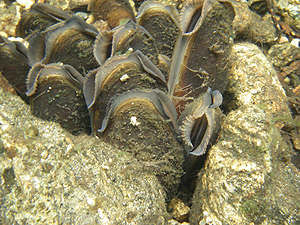 River pearl mussels in Västernorrland, Sweden. Photo: Joel Berglund. |
River pearl mussels (Margaritifera margaritifera) are among the largest European freshwater mussels, their very thick walled shells can grow to 140 mm in length. Equally astonishing is their possible age: While in Central Europe river pearl mussels have been found 80 to 100 years of age, in the North of their distribution area, for example in Sweden, they can grow to more than 200 years. In Spain, too, over 100 years old river pearl mussels have been found. This high life expectancy is due to their extremely low metabolism. However, this also requires the river pearl mussels to live in oxygen-rich environment, usually found in cold, fast flowing streams.
River pearl mussels are rather inconspicuous, younger specimens are darkish brown, older specimens usually are matt black in colour, The umbones of adult river pearl mussels usually are corroded and degraded, where the two shell valves meet.
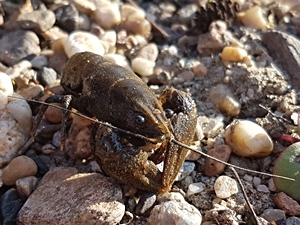 European crayfish (Astacus astacus): Styria, Austria. Photo: Daniel Arzberger (iNaturalist). |
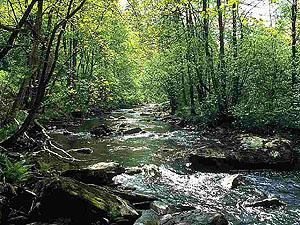 |
|
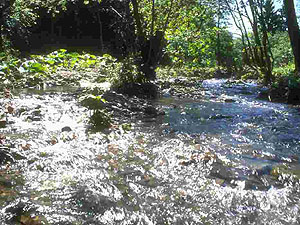 Streams suitable for river pearl mussels have to be fast flo- wing, cold in summer and poor in limestone. |
River pearl mussels occur between 40 and 70 degrees northern latitude, the northern arctic circle establishing the climatic northern border of their distribution.
Worldwide, the spread of river pearl mussels by glochidia and thus their area of distribution is basically connected to that of the river trout (Salmo trutta fario), since the river pearl mussel depends on the presence of that fish species.
In Europe, the river pearl mussel is present in low mountain ranges from Spain as far as Russia, from Scandinavia as far as the Alps. In Austria and Germany, the river pearl mussel is the only members of the Margaritiferidae family, while all other large freshwater mussels of the Unionidae superfamily are members of the Unionidae family. In Spain there is another relative of the European river pearl mussel, the large river pearl mussel (Pseudunio auricularis). About 7 to 12 species of Margaritiferidae are estimated worldwide.
Like river mussels, river pearl mussels live by filtration: From their breathing water, they filter plankton and detritus using their gills. Thus, similar to the blue mussels in the Wadden Sea, river pearl mussels fulfil an important ecological task. Equally similar to those, they are likewise very susceptible to changes in water quality.
Links
River pearl mussels do not become mature until the advanced age of about 15 years. Similar to other domestic large river mussels, fertilisation takes place in the pallial cavity in the female mussel's body, after it had collected male sperm cells from the stream of breathing water. The river pearl mussel equally develops via a parasitic larval stage, the so-called glochidia, which are released into the surrounding water and then sink to the stream floor. Each female river pearl mussel annually produces about four million glochidia, about 0,07 mm in size. Those already possess a bivalve shell equipped with shell hooks they can use to cling on the gill filaments of a fish passing by and stirring up the mussel larvae from the floor.
A river pearl mussel's glochidia are extremely host specific: The are exclusively capable to infect the gills of a river trout (Salmo trutta fario), or, in Northern Europe, a salmon (Salmo salar), and to be able to continue their development. However, the infection of a host fish can also be considered a symbiosis, since the fish definitively profits from the mussels filtering the water and thus improving water quality. After the glochidia hibernated in the fish's gills, the fall off in June the next year and develop into juvenile mussels. The next five years they spend in the stream floor and only reappear with a size of about a centimetre. By that time, about 95% of juvenile mussels have died. The largest part of them falls prey to different animals, but also the decreasing water quality in many streams (oxygen content and sediment intake) demands its tribute.
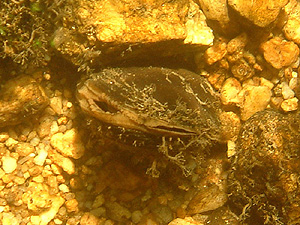 A river pearl mussel. Photo: Christoph Riegler. |
Like in sea-living pearl mussels, in freshwater pearl mussels the pearls are built in the pallial epithelium. Foreign objects are coated in layers of aragonite, so that after some time a pearl evolves. A pearl 4mm in diameter, produced by a freshwater pearl mussel, needs 20 to 25 years to grow! Only one in 3000 mussels even contains a pearl. Since in Europe in historic times, river pearl mussel were so abundant that they were even collected as food source, the harvesting of pearls from those mussels proved to be an economically sound concept. However, since only a small number of them actually contained a pearl, very many of them had to be collected and killed to aquire an economically feasible number of freshwater pearls.
During the Middle Ages, therefore, the pearl fishery very soon became a monopoly of clerics and nobility, as such the owners of the respective water bodies, and illegal pearl harvesting was punished draconically, signs illustrating that fact for the illiterate peasantry were placed on the riverside.
Not only the pearls, also the inner coating of the shell was used. Nacre or mother-of-pearl, scientifically the mussel shell's hypostracum, with its iridescent aragonite crystals was manufactured in many things, from buttons to glass frames, before the emergence of chemically based plastics.
![]() Dustin Lemick: "The
Science of Pearls: How Mollusks Make Jewelry". Brite.co, June, 2025.
Dustin Lemick: "The
Science of Pearls: How Mollusks Make Jewelry". Brite.co, June, 2025.
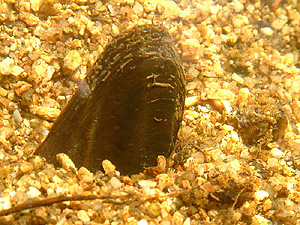 River pearl mussel. Photo: Christoph Riegler. |
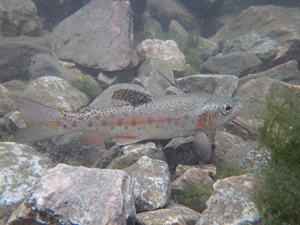 Rainbow trout (Oncorhynchus mykiss): Pasadena, USA. Photo: Susan Hopkins (iNaturalist). |
The final straw was the introduction of the American rainbow trout (Oncorhynchus mykiss, Photo on the left) for economic fishery. The rainbow trout not only decimates the juvenile domestic river trouts. Also, contrary to the river trout (Salmo trutta fario), the river pearl mussels' glochidia are incapable to use the rainbow trout as a host fish.
Here, the European otter (Lutra lutra) is helpful, since it decimates the rainbow trouts, where it has been resettled and thus gives and advantage to the river pearl mussels, which are not among its prey, contrary, by the way, to other freshwater mussels. Similar to the river mussel, the river pearl mussel has severely been harmed by the muskrat (Ondathra zibeticus), also introduced from America.
![]() Fresh water mussels in danger.
Fresh water mussels in danger.
Latest Change: 23.10.2025 (Robert Nordsieck).